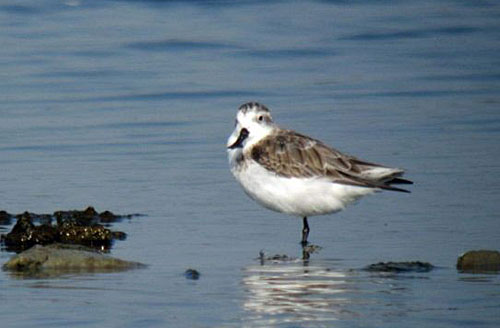
Spoon-billed Sandpiper Photo: David Sibley
Thailand is a fascinating country with many wonderful national parks and reserves supporting huge numbers of resident and wintering birds and is also home to a rich and ancient culture.
Our tour visits the marshy plains, mangrove coastline, and salt pans at Pak Thale and Laem Phak Bia south of Bangkok where we may encounter nearly 40 species of shorebird including the threatened Nordmann’s Greenshank and Asian Dowitcher and the critically endangered Spoon-billed Sandpiper, and two splendid national parks at Khao Yai and Kaeng Krachan, each with vast tracts of uninterrupted evergreen forest supporting a wide mix of northern and southern bird species as well as a wide variety of mammals. At Kaeng Krachan we’ll also visit several established blinds where normally secretive birds come to feed.
This tour can be taken in conjunction with our tour, Thailand: The Northwest.
Day 1: The trip begins at 6:00 p.m. with a meeting in the lobby of our Bangkok hotel. Night near Bangkok’s international airport.
Day 2: We’ll begin in a small marshy area near the old Bangkok airport, where we’ll find a variety of wintering warblers, possibly including Black-browed Reed, Dusky, Oriental Reed, Yellow-browed, and with very good luck Pallas’s Grasshopper (we should at least hear it). We may also see Bluethroat and Eastern Yellow, White (the white-faced leucopsis subspecies), and possibly Citrine Wagtails. We should find White-breasted Waterhens and Ruddy-breasted Crakes lurking among the reeds, and Cinnamon and especially Yellow Bittern are possible. We will visit several temples, where we should see Red-breasted Parakeet and possibly Spotted Owlet as well as hundreds of Lyle’s Flying Foxes (fruit bats).
Later we’ll drive to Ayutthaya, the former capital of Old Siam until sacked by the Burmese in 1767, stopping en route to examine concentrations of feeding Asian Openbills in marshy fields. We will have lunch at a riverside restaurant near the ruins of this striking capital city. We often see Pied Kingfisher along the river here while dining. We’ll depart Ayutthaya and head towards Khao Yai National Park, stopping late in the afternoon at Wat Phra Phutthabat Noi, a temple built amongst the steep limestone karst formations. Our main goal here is to find the Rufous Limestone-babbler (Turdinus calcicola), a recent split from its two other sister species. It is a vulnerable endemic species with a small range in this part of Thailand. Here we might also see Eurasian Hoopoe and Linneated Barbet as well as Long-tailed Macaques. We will continue to Khao Yai, arriving by early evening at our comfortable resort near Khao Yai’s northern gate. Night near Khao Yai National Park.
Days 3–5: We will spend three days exploring the densely forested hills, clear rivers, and waterfalls at Khao Yai National Park, one of the best-preserved tracts of tropical evergreen forest in all of Indochina. Khao Yai is noted particularly for larger forest birds, among which are four species of hornbill, including the magnificent Great, as well as Orange-breasted and Red-headed Trogons, Banded Kingfisher, Banded and Long-tailed Broadbills, and sometimes Sultan Tit. We can also expect a fine collection of raptors, pigeons, barbets, woodpeckers, leafbirds, bulbuls, laughingthrushes, babblers, warblers, sunbirds, and flowerpeckers. Red Junglefowl and Siberian Blue Robin haunt the undergrowth, and there is a chance of finding other, scarcer ground birds such as the elegant Siamese Fireback, Silver Pheasant, and the elusive Coral-billed Ground-Cuckoo or Blue Pitta. At dusk we’ll look for Great Eared-Nightjars. If we have missed Siamese Fireback we may drive northeast to the Sakaerat Environmental Research Station. We have had good luck finding them in recent years on a walk of about a kilometer from the station.
Khao Yai is also extremely rich in mammals, including Pig-tailed Macaque, gloriously vocal gibbons (both White-handed and Pileated are present), Black Giant Squirrel, civets, Sambar and Barking Deer (Red Muntiac), East Asian (Malaysian) Porcupine, and Asian Elephant. Nights near Khao Yai National Park.
Day 6: This morning we’ll head for the coastal town of Laem Phak Bia and hope to make it to Fisherman’s Resort, our home for the next three evenings, shortly after lunch. Nearby we’ll take a boat out to a spit of land that extends out into the Gulf of Thailand. For at least a decade, one or two White-faced Plovers (Charadrius dealbatus) have wintered on this sand spit; the species was first collected in 1861 by Swinhoe, who described it as a new species in 1870—after which it was forgotten for well over a century! Some taxonomists regard this as a separate species while others treat it as a subspecies of Kentish Plover. We’re also likely to see Chinese and Pacific Reef Egrets, Malaysian Plover, Greater Crested, and possible Lesser Crested Tern. Brown-headed Gulls should be numerous and there is a chance for a rarer gull such as a Pallas’s, Black-tailed, Slender-billed, or Heuglin’s. As we head out, or return, through the mangroves we’ll watch for Striated Heron, Collared and Black-capped Kingfishers, and watch overhead for Brahminy Kites. Late in the day hopefully, we’ll have time to visit the Royal Project, only a few minutes away, where we might see Javan Pond Heron, Slaty-breasted Rail, and Ruddy-breasted Crake, and both Pin-tailed Snipe and Greater Painted-Snipe. White-shouldered (sometimes with Daurian) Starlings sometimes come into the mangroves here to roost along with large numbers of Black Drongos and Blue-tailed Bee-eaters. Night at the lovely beachfront Fisherman’s Resort, near Laem Phak Bia.
Day 7: We will spend much of the day birding the brackish and saltwater mudflats, sandflats, mangroves, and salt pans of Phetchaburi Province in the western sectors of the Gulf of Thailand. We’ll search for 40 or more shorebird species, including Red-necked, Long-toed, and Temminck’s Stints, Great Knot, Broad-billed, Marsh Sandpipers, Common and Spotted Redshanks, Pied Avocet, and Greater and Lesser Sand Plovers. Amongst the large flock of wintering Eurasian Curlews, there are usually a few Far Eastern Curlews present. If we’re lucky, we may see the endangered Spoon-billed Sandpiper (there were about three individuals here in 2019), the threatened Nordmann’s Greenshank, and possibly Asian Dowitcher. Night at Fisherman’s Resort.
Day 8: In the early morning we will return to the Royal Project near Laem Phak Bia, searching for additional marsh birds such as Yellow Bittern, Watercock, Bronze-winged Jacana, and a variety of warblers, including Oriental and Black-browed Reed. Later we will travel to the open country an hour or so away that is particularly good for raptors. Among the many wintering Black Kites, we will be looking for eagles: Greater Spotted is the most likely, but we have at least a chance of seeing Booted, Imperial and Steppe as well. The numbers present are highly dependent on the timing of the burning of the rice fields. In some years raptors have been few and if so we’ll visit a nearby wetland which hosts many wintering ducks, including Garganey. Painted Storks and Black-headed Ibis might be present as well, and there is at least a faint chance of seeing a Black-faced Spoonbill or Spot-billed Pelican. In recent years we have had our best luck finding Asian Dowitchers amongst the Black-tailed Godwits; in 2020 we counted 46. At some point we may visit nearby Bang Khun Sai. An interesting feature of the town is its “swift apartments,” multi-story concrete structures built by Chinese investors to house wild Germain’s Swiftlets. Thousands of pairs nest in the most favored apartments, each with its own set of (human) managers and a speaker system that broadcasts swift calls at high volume in hopes of attracting additional recruits; the nests reportedly sell for upward of $2,500 per pound in Chinese markets. Night at Fisherman’s Resort.
Day 9: This morning we’ll make our way to Kaeng Krachan National Park, with a stop along the way at Kaeng Krachan Country Club, where we might see Indian Thick-knee, Rufous Treepie, Indochinese Bushlark, and Grey-breasted Priniabefore. Before we reach the park we’ll likely visit one of several blinds established near the park entrance. These sites are excellent for several secretive species that are quite difficult to see in the field, including Scaly-breasted and possibly Bar-backed Partridges, Kalij Pheasant, Greater and Lesser Necklaced Laughingthrushes, Siberian Blue Robin, and Indochinese Blue-flycatcher. From time to time even the secretive forest Slaty-legged Crake visit these sites along with Gray Peacock-Pheasant, Ferruginous Partridge, and even Blue and Eared Pittas, although we would be lucky to see them. Night at a lodge near the park entrance.
Days 10-12: Kaeng Krachan, with its range of habitats from drier deciduous forest to huge expanses of evergreen forest, is a wonderful place to watch birds. We’ll spend three days and a final morning exploring this region. At middle elevations we’ll search for Tickell’s Brown Hornbill and five species of broadbills, including Black-and-yellow, Black-and-red, Banded, Dusky, and Silver-breasted. Wintering Palearctic species should be numerous and might include some more southerly winterers like Eastern Crowned Warbler and Chinese Blue-flycatcher. If the road has been fixed, at our highest point we’ll be searching for Ratchet-tailed Treepie at its only location in Thailand, along with its frequent traveling companion the striking Collared (White-hooded) Babbler. Black-throated Laughingthrush occur here too, and we have at least a chance of seeing Spot-necked Babbler, Yellow-vented Pigeon, Red Bearded Bee-eater, Long-tailed Broadbill, Greater Green Leafbird, and Dark-sided Flycatcher, a winter visitor from the north. At this season many Oriental Honey-Buzzards should be moving north. Other raptors we might see include Black Eagle and Mountain Hawk-Eagle and with good luck an Oriental Hobby. During the monsoon season of 2018, the road was washed out and political wrangling since about what type of road to re-build, has prevented any fixing of the road and it has remained closed through at least the spring of 2020. If it is still closed in 2021, we will spend more time in the blinds where the list of uncommon to rare species we might encounter is very long and every year is different. In 2020 it included a King Cobra!
In the drier deciduous forest, woodpeckers are particularly numerous, and we could see more than ten species including Black-naped (a split from Grey-headed), Common and Greater Flamebacks, Greater Yellownape, Streak-breasted, and possibly Great Slaty.
The park harbors many mammals too, and we might encounter Asian Elephant, Golden Jackal, Fea’s Muntjac, Crab-eating Mongoose, Dusky and Banded Langurs, Stump-tailed Macaque, and possibly Dhole and even Gaur. Several cats also occur here, Leopard being the most frequently seen but also Tiger, although we would be exceptionally lucky to see one. Dusky Langurs, along with a few Banded, are present, as are the distinctive Stump-tailed Macaques. Nights at a lodge near the park entrance.
Day 13: This morning is flexible and we’ll likely make another visit to the blinds looking for things we may have missed earlier or make another trip inside the park. We may also check for raptors again on our way back to Bangkok and perhaps something notable will have turned up in one of the Bangkok parks. Night at the Novotel near Bangkok’s international airport.
Day 14: The tour concludes this morning after breakfast.
Updated: 26 May 2020
Prices
- 2025 Tour Price Not Yet Known
- (2024 Tour Price $5,290)
Notes

Questions? Tour Manager: Greg Greene. Call 1-866-547-9868 (US or Canada) or (01) 520-320-9868 or click here to email.
* Tour invoices paid by check carry a 4% discount. Details here.
Maximum group size ten with one leader and a local guide.
